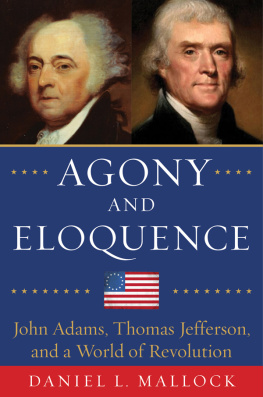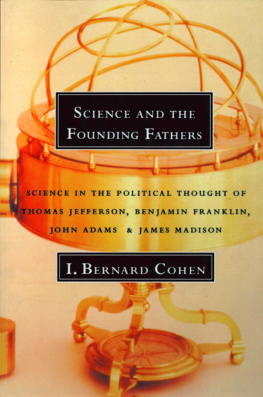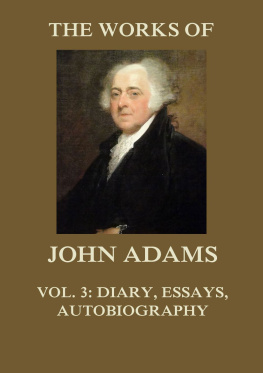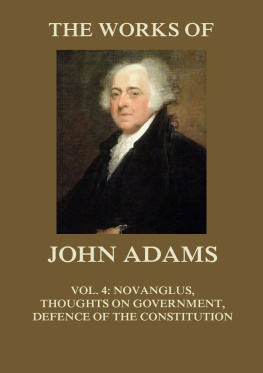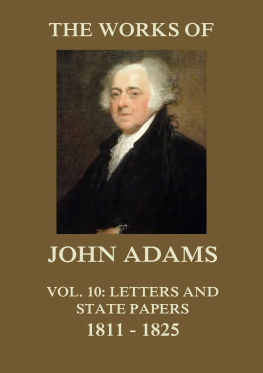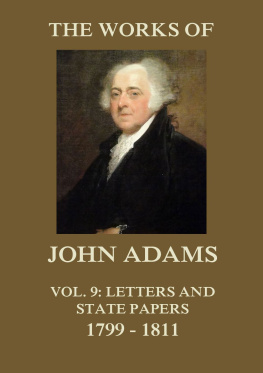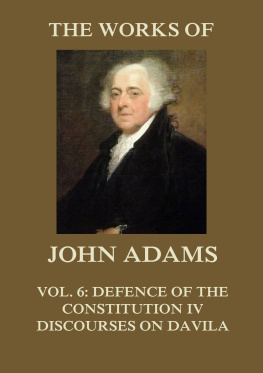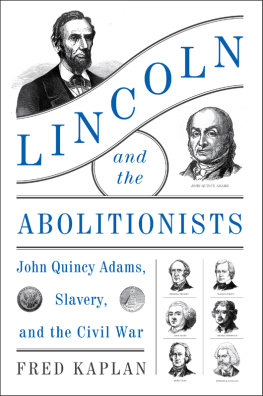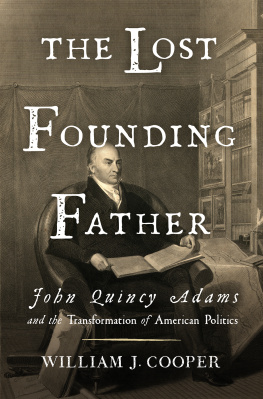Adams John - John Adams : a life
Here you can read online Adams John - John Adams : a life full text of the book (entire story) in english for free. Download pdf and epub, get meaning, cover and reviews about this ebook. City: United States, year: 2012, publisher: The University of Tennessee Press, genre: Non-fiction. Description of the work, (preface) as well as reviews are available. Best literature library LitArk.com created for fans of good reading and offers a wide selection of genres:
Romance novel
Science fiction
Adventure
Detective
Science
History
Home and family
Prose
Art
Politics
Computer
Non-fiction
Religion
Business
Children
Humor
Choose a favorite category and find really read worthwhile books. Enjoy immersion in the world of imagination, feel the emotions of the characters or learn something new for yourself, make an fascinating discovery.

- Book:John Adams : a life
- Author:
- Publisher:The University of Tennessee Press
- Genre:
- Year:2012
- City:United States
- Rating:4 / 5
- Favourites:Add to favourites
- Your mark:
- 80
- 1
- 2
- 3
- 4
- 5
John Adams : a life: summary, description and annotation
We offer to read an annotation, description, summary or preface (depends on what the author of the book "John Adams : a life" wrote himself). If you haven't found the necessary information about the book — write in the comments, we will try to find it.
John Adams : a life — read online for free the complete book (whole text) full work
Below is the text of the book, divided by pages. System saving the place of the last page read, allows you to conveniently read the book "John Adams : a life" online for free, without having to search again every time where you left off. Put a bookmark, and you can go to the page where you finished reading at any time.
Font size:
Interval:
Bookmark:
John Adams

A LIFE
John Ferling

Copyright 1992 by The University of Tennessee Press / Knoxville.
All Rights Reserved. Manufactured in the United States of America.
First Edition.
Frontispiece: John Adams in 1783, aged forty-eight. Oil on canvas by John Singleton Copley. Courtesy: Harvard University Portrait Collection. Bequest of Ward Nicholas Boylston, 1828.
The paper in this book meets the minimum requirements of the American National Standard for Permanence of Paper for Printed Library Materials.

The binding materials have been chosen for strength
and durability.
Library of Congress Cataloging in Publication Data
Ferling, John E.
John Adams : a life / John Ferling.
p. cm.
Includes bibliographical references and index.
ISBN 0-87049-730-8 (cloth : alk. paper)
1. Adams, John, 1735-1826. 2. PresidentsUnited States
Biography. I. Title.
F322.F47 1992
973.44092dc20
[B] 91-14036 cip
PART ONE
Love of Fame
PART TWO
An Epocha in History
PART THREE
Safe and Glorious in the Harbour of Peace
PART FOUR
One Man of Inflexible Integrity
PART FIVE
I Still Live and Enjoy Life
I FIRST ENCOUNTERED JOHN ADAMS, I think, when as an undergraduate I was assigned to read a few pages of his diary. I did not find him endearing. He appeared obsessive, neurotic, unhappy, and, worst of all, humorless.
Probably because of the impression I had formed, I rather successfully avoided Adams for the next twenty or so years, until research for a book on Americas early wars obliged me to reacquaint myself with him. I had wondered how Adams, who never served in the military, coped emotionally with the French and Indian War, which had erupted when he was in his prime, and with the War of Independence, which as a member of Congress he had helped bring about. This time I found Adams very different. He seemed to be more humanand full of contradictions. Still troubled, he also seemed to be meditative, insightful, and provocative, though at times didactic. He was sometimes churlish, but in private and with friends he could be engagingly witty. He was terribly self-centered, but in his relationship with his wife and children his shortcomings were tempered by a deep, abiding love.
The research on early American warfare also led me to George Washington, who, like Adams, was a terribly complex individual. A biography of Washington followed, but throughout my work on him I knew that someday I would come back to Adams. There were simply too many questions to be answered, questions about his public conduct and his private life.
I confess that at the outset of my work on Washington and Adams I was intrigued with each man but liked neither. My feelings changed as each work progressed. Toward Washington, I felt profound admiration blossom. Toward Adams, I felt esteem and affinity burgeon, although those feelings were tempered by repugnance for the way he often treated his family.
It was my good fortune to come to know both men, especially Adams, the less Olympian of the two, a man of more common attributes who struggled mightily for every achievement and whose integrity and unyielding commitment to principle are often unknown virtues today.
This study could not have been completed without the assistance of many others. Considerable financial support was provided by the Learning Resources Committee of West Georgia College. Albert S. Hanser and James T. Gay generously cooperated by providing teaching schedules that afforded time for research and writing. Dean Richard Dangle of West Georgia College made available funds for a trip to comb through papers whose existence I discovered only at the last minute. Elmira Eidson, who efficiently manages the history department of which I am a member, helped in countless ways.
I am indebted to numerous people who provided kind assistance in the course of my research. Long days and nights away from home were made more pleasant by the amenable aid I received from the librarians and historians in several libraries. I am grateful for the many courtesies extended at the American Antiquarian Society, the Boston Public Library, the Houghton Library of Harvard University, the Library of Congress, the New-York Historical Society, the New York Public Library, the National Archives, and the Pennsylvania Historical Society. I am particularly indebted to Peter Drummey, Virginia Smith, and numerous others at the Massachusetts Historical Society who patiently answered my questions, assisted in my searches, and suggested helpful avenues to pursue.
Several librarians at the Irvine Sullivan Ingram Library of West Georgia College provided invaluable assistance, especially Nancy Farmer and Deborah Novak who cheerfullyI thinkresponded to what must have seemed my unending requests for materials through interlibrary loan.
Edith B. Gelles, Gregg L. Lint, and James Kirby Martin read the manuscript at various stages and offered many valuable suggestions for improvement.
I am indebted to Cynthia Maude-Gembler and Tana McDonald who believed in this undertaking and helped with its completion. And I am grateful to Lee Campbell Sioles and Jean Tyrone, without whose assistance a very different book would have appeared.
I owe a special debt to Ara Dostourian, who opened his home to me during several research trips to New England.
Finally, to Carol, who has always shared and supported my love of scholarship, whatever the burden or the pain.
John Adams
LIFE, FOR MOST AMERICANS, did not change significantly between 1735, the year of John Adamss birth, and 1826, the year of his death. Although the two dates were separated by nearly a century, most people continued to live and work on farms. Daily life had a rhythm, a tempo set by nature, which governed the practice of agriculture. In New England, men, often accompanied by their sons, trudged to the fields in March to inaugurate the season with ditching. Then came plowing, planting, mowing, weeding, and harvesting, until the annual cycle ended with the slaughter of livestock in mid-autumn. The wives and daughters also had economic responsibilities within the family, the same chores, in fact, that their European ancestors had performed centuries before: they tended the poultry, milked the cows and made butter and cheese, grew vegetables in summer, gathered fruit in early fall, assisted with the butchery of the stock, sewed, spun, washed, cleaned, cooked, and cared for the children.
Labor was manual, and the tools with which the farm families of 1826 worked were similar to those used by their predecessors four generations earlier. Men struggled with plows made of ash, wielded metal axes, hoes, scythes, and crosscut saws, and swung a heavy cradle to harvest grain under a hot September sun. Women cooked in a vast open fireplace, sewed and made candles without the assistance of machinery, and on the ritual Monday washday still plunged their arms into near-boiling water to scrub the clothes.
In both periods most people married in early spring or late fall, so the newlyweds would have some time to themselves before the demands of the farm encroached; most frequently, the childrenfive or six living children per family on averagewere born in late winter or early spring and customarily arrived at about thirty-month intervals. Few people received more than two or three years of formal education. Unless a new frontier beckoned, few people traveled beyond the immediate area of their birth, and most people got about by walking, on horseback, or in a horse-drawn conveyance. A vaccination against smallpox was developed in the eighteenth century, but few other advances in medical science were made and both eras demonstrated a terrible
Next pageFont size:
Interval:
Bookmark:
Similar books «John Adams : a life»
Look at similar books to John Adams : a life. We have selected literature similar in name and meaning in the hope of providing readers with more options to find new, interesting, not yet read works.
Discussion, reviews of the book John Adams : a life and just readers' own opinions. Leave your comments, write what you think about the work, its meaning or the main characters. Specify what exactly you liked and what you didn't like, and why you think so.

